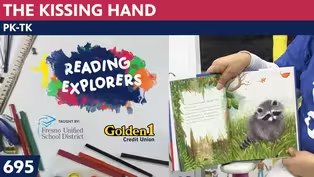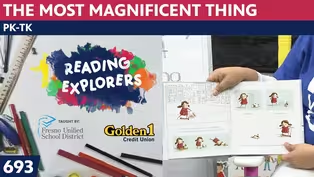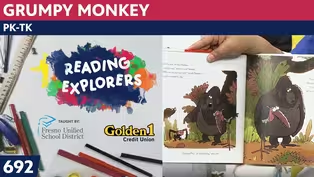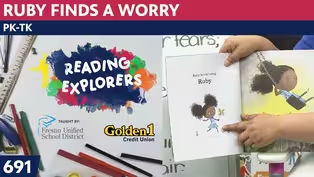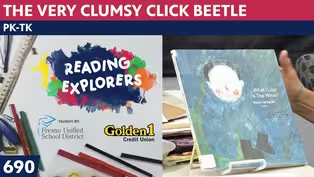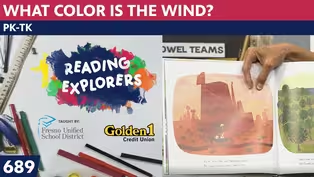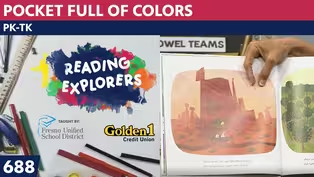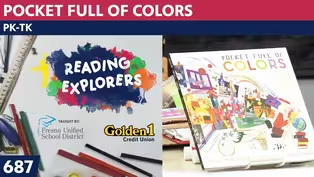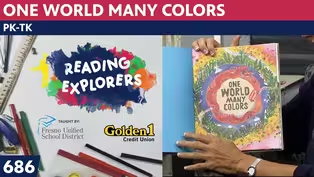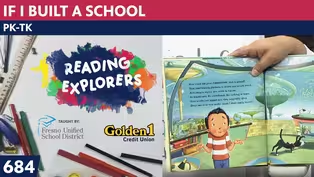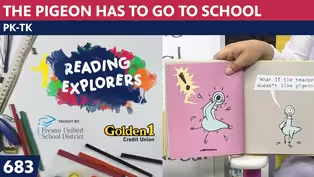
TK-388: Electric Prisms
Season 3 Episode 496 | 14m 4sVideo has Closed Captions
Join Mrs. Readwright at Camp Discovery!
Join me today as we continue our study of Sonia Delaunay. She is famous for her geometric shape art. Each day we will use a different medium (materials or supplies) to create our art. If you want to create art like "Electric Prisms" in the style of Sonia Delaunay, bring white paper, a collection of circles to trace, (or a compass), a ruler, a pencil, chalk pastels, and paper towels.
Problems playing video? | Closed Captioning Feedback
Problems playing video? | Closed Captioning Feedback
Reading Explorers is a local public television program presented by Valley PBS

TK-388: Electric Prisms
Season 3 Episode 496 | 14m 4sVideo has Closed Captions
Join me today as we continue our study of Sonia Delaunay. She is famous for her geometric shape art. Each day we will use a different medium (materials or supplies) to create our art. If you want to create art like "Electric Prisms" in the style of Sonia Delaunay, bring white paper, a collection of circles to trace, (or a compass), a ruler, a pencil, chalk pastels, and paper towels.
Problems playing video? | Closed Captioning Feedback
How to Watch Reading Explorers
Reading Explorers is available to stream on pbs.org and the free PBS App, available on iPhone, Apple TV, Android TV, Android smartphones, Amazon Fire TV, Amazon Fire Tablet, Roku, Samsung Smart TV, and Vizio.
Providing Support for PBS.org
Learn Moreabout PBS online sponsorshipMore from This Collection
Valley PBS and Fresno Unified School District have partnered with Golden 1 Credit Union to create Reading Explorers Lessons for grades Pre-Kindergarten through Third grade. The daily lessons will be taught by Fresno Unified School District teachers and are created to help students practice their reading skills and reinforce lessons during distance learning.
Video has Closed Captions
Valley PBS presents Reading Explorers Lessons for Pre-Kindergarten and TK. (26m 27s)
PK-TK-693-The Most Magnificent Thing
Video has Closed Captions
Valley PBS presents Reading Explorers Lessons for Pre-Kindergarten and TK. (26m 26s)
Video has Closed Captions
Valley PBS presents Reading Explorers Lessons for Pre-Kindergarten and TK. (26m 28s)
Video has Closed Captions
Valley PBS presents Reading Explorers Lessons for Pre-Kindergarten and TK. (26m 28s)
PK-TK-690: The Very Clumsy Click Beetle
Video has Closed Captions
Valley PBS presents Reading Explorers Lessons for Pre-Kindergarten and TK. (26m 22s)
PK-TK-689: What Color is the Wind?
Video has Closed Captions
Valley PBS presents Reading Explorers Lessons for Pre-Kindergarten and TK. (26m 21s)
PK-TK-688: Pocket Full of Colors
Video has Closed Captions
Valley PBS presents Reading Explorers Lessons for Pre-Kindergarten and TK. (25m 58s)
PK-TK-687: Dancing Through Fields of Colors
Video has Closed Captions
Valley PBS presents Reading Explorers Lessons for Pre-Kindergarten and TK. (26m 20s)
PK-TK-686: One World Many Colors
Video has Closed Captions
Valley PBS presents Reading Explorers Lessons for Pre-Kindergarten and TK. (27m 13s)
PK-TK-685: School is Wherever I am
Video has Closed Captions
Valley PBS presents Reading Explorers Lessons for Pre-Kindergarten and TK. (26m 32s)
PK-TK-684: If I Built a School
Video has Closed Captions
Valley PBS presents Reading Explorers Lessons for Pre-Kindergarten and TK. (26m 21s)
PK-TK-683: The Pigeon Has to Go to School
Video has Closed Captions
Valley PBS presents Reading Explorers Lessons for Pre-Kindergarten and TK. (26m 22s)
Providing Support for PBS.org
Learn Moreabout PBS online sponsorship♪ Good morning to a brand new day ♪ ♪ Time to learn and the games to play ♪ ♪ Learning things is so much fun ♪ ♪ Learning is good for everyone ♪ (upbeat music) - Hello, early learners, and welcome back to the art room.
This week, we've been talking about Sonia Delaunay and she was a Russian artist married to another artist.
And she had started out by making that quilt for her baby using design she'd seen on fabric in the homes of peasant people in Russia.
And then she went to live with that very rich uncle and aunt who took care of her and took her to all the museums, and she saw more beautiful things and she kept adding, whatever she saw, she added to her artwork and her ideas.
And every time you go out in the world what if you look at things and think, oh, I could draw that.
Or I could paint that, or let me remember how that sounded.
And you will get your mind to be full of rich artistic things, which makes us all a rounded kind of personality.
Boys and girls, you might see, and remember that the balloons and the celebration is because this is our last week together until after school starts again.
So, I'm glad you're here this week and we are enjoying Sonia Delaunay's artwork and we're doing all of the things that she used circles for.
I even wore a circle skirt today so that you could see I was celebrating her and it's in concentric circles out, out, out, out, out different designs.
And today, we're going to paint, first we did oil pastels on Monday, we did chalk pastels on Tuesday, and now today that it's Wednesday, we're going to be painting with tempera paint.
And I told you I don't really like to use just the color straight out of the container, I like to mix them together and make tents by adding color onto some white.
And I could mix it right on my paper in the circles if I want.
And I'm showing you I have all my water color brushes that I'm going to use because they come in different sizes and I put water in all of them.
Like this one is a very thick brush and flat, this one is a round pointy one.
And this one is another brown pointy one just a little bigger than that one.
And I'll set them over here because I'm first going to draw my circles so that I can paint them in.
So let me set this in the pointer stick aside and pick up the table.
And you'll see, I have my collection of all of my circles.
And I also have waiting in the wings, my compass if I want to make something giant because what we're going to do, is talk about this print.
And this print has one, two, three circles in a straight line, and it divided with a straight line almost to the tippy top.
And that she usually did lines through the circles, I told you.
So what we'll do is keep this here, and I have, or I could just use my little one.
I made a little one when I was running off the directions that I wanted to remember what to bring.
So I'll just leave that one there.
If I need this one, I will bring it out.
All right, so first comes to the drawing part.
So let me use this.
And I'm using a skinnier black pen because I thought the black showed up a lot on the other pieces.
And I want it to be a little smaller.
I'm dumping those out because remember I told you it's much easier to start with the biggest circle and go down.
And the outline of it, there is a couple of circles that do in a 1/2 circle way, oh, I better do the straight line down the middle first 'cause that's where it's going straight down the middle with the line.
And I put the pin up against the ruler and pushed down a little harder.
I tested out this pen and it looks like it's kind of drying out.
I have another one here.
Let's see, I think I might not have clicked it, remember when you were using the pens, you have to hear the snap of the lid or they dry out and on these permanent pens, it's not easy to bring them back to life.
The watercolor ones, you usually can bring it back to life by dipping it in water for a minute.
Or you can even make watercolors with a worn out pen, you can put the pen into a jar of water and have the water, make the ink come out of the pen and you can use it that way.
So here's my gigantic circle, and I'm going to put a smaller one inside it, and go around it, and I'll go into a smaller one, all the way down to the smallest one I have.
I had to move to my pencil, boys and girls, because my pen seemed to dry it out and it didn't look like it was going to make a big enough line for me to follow.
And then I'll start a smaller one down here.
I'm pretending it's kind of like those electric prisms of the lights in Paris.
I think I made some too many circles that are the same size.
So I'm going to have to figure out if I can just do it free hand and just make a circle around there.
It'll be good enough.
And then outside they have some circles that go just to the edge.
So I'll do that from that edge to that edge.
I'll move it over and can use your paints, and if you don't have paints, you know what you can do use any of your other coloring tools.
That's enough lines I think to start.
And they say, Sonia Delaunay didn't like to put the same colors next to each other, otherwise it ended up just looking like one circle around that area.
I'm gonna start out with color, I think I'll put like a sunny color in the middle.
So I'll put yellow here, go to the edge and kind of keep it there.
I can fill that in nicely, and I'll use my yellow somewhere else, maybe right here.
So I don't have to wash my brush in between each one.
I can just paint and fix it up to there.
But if I wanted to make like a yellow, green, I could mix that in my lid, mostly yellow and a dot of green.
When you're mixing the colors, start with the lighter color and mix in the darker hue after because otherwise you can't make it lighter very easily.
I think I'll put the green next to that yellow 'cause there are analogous colors.
Do you remember what analogous is?
Right next to each other on the color line?
Here we go, circling it in, since I didn't draw the line I have to kind of guess how far away from it it is.
I think I'll do this one and keep it.
Oops, I went too far but I can cover over that with a darker one maybe.
Or maybe I'll mix a blue and a green together and make them be the analogous color on this opposite side.
Still the staying close to the line.
I don't know if you can paint more carefully than I am, it seems like I keep bumping into things.
Oh, there I'll put that blue and green together and make kind of a, oh, it looks like mud to me.
Maybe I'll put some white in there.
Ooh, it looks like a forest color.
I'm not sure I love it.
Maybe I'll put it on a small place and see if I do like it.
Oh, it's okay, it's an okay color.
I don't think there are any bad colors but does it look good with what I'm working on is what I'm wondering.
Okay, I think I'll get a smaller brush, put this in the water.
Maybe a smaller brush will do, let me get up closer to things.
I'm gonna put some red next to this yellow and I will go back and get a little orange 'cause remember I told you I like it to be a mix so it doesn't look just like the color right out of the bottle.
And red and orange are next to each other on the color wheel.
And orange and yellow are next to each other on the color wheel.
Put orange in this one just go up next to the edge, and if I put my hand on paper like this and it steadies my hand a little bit more.
'Cause when you have your hand up like this you can't really steady it.
But if you have it, you anchor it to your paper and you can set it down and push and pull and I can move my brush this way to get it next to the line.
And if you make it next to the line when you make the curve, it stays pretty good.
And if you mix in with another color next to it, especially if it's on the color wheel next to it, analogous, it doesn't look so bad if you just blend it into your space that's kind of what I'm thinking I'm doing.
Getting close to it and stop.
I'll dip in, get a little bit more right here 'cause my brush started to get a little dry and I do like it to be a solid color.
That looks pretty good.
I think I'll still use orange and maybe put it in this one maybe next door to this.
Are you painting along with me or you just thinking about, oh, I'm gonna remember to do that orange next to the green, it looks like an orange tree.
Maybe the tree is green and the leaves are green and the fruit is orangy.
You can figure out what your favorite color combinations are.
I know sometimes when I work on things, I think, oh, I'm gonna remember those colors together.
That's how I ended up thinking that orange and magenta look really good together.
I'm gonna do kind of a peachy color on this one with more white and a little less orange in there.
I'm dipping in and getting more.
'Cause that lid makes it easy to mix my colors up.
If I put that one in here, oh, that looks good, It's smooth.
It kind of looks like cantaloupe to me.
I keep talking about food, maybe I'm hungry.
I like to do this one next to this, stop at this line, maybe so.
And when you use a warm color and a warm color and a warm color, I should do some cool colors somewhere, maybe on that side, I will.
It stops with the line from this circle so I'm gonna put a different color in there.
Maybe I'll make it even lighter.
Add some yellow to it, see what color that makes.
Oh, it kind of looks more peachy too but I'm not sure if I love it.
Oh, it is very different, it looks like a peach crayon in the crayon box.
Do you ever look at the colors and think, oh, I would have named this one a different color.
When I was a little girl, I would look at the crayons and sometimes I put masking tape on them and made my own name of them, of things that I've seen in nature and change the color of the crayons.
I could have been a color of crayon maker.
Maybe that could have been a job for me.
I'll put some yellow with white and make it a lemony one.
The yellow and white makes a lemony color, oh, it makes it kind of sunny.
It is making it another warm color.
I think I'll put that one right here.
Is it too close to that one?
Not really, I wonder if you can see the difference when on camera.
I know when we've been working from zoom or from the teams, you think, oh, my teacher can see one thing, but I see another because sometimes the camera distorts what you're seeing.
Let me wash this brush.
Maybe I'll use one of these watercolor ones and get in here and use a little more red.
Maybe I'll make a pink for it, mix it up.
You know, it's a good idea to always start with the white and then add the color because it's hard to turn back but I'm gonna make this one pink.
I'm gonna put it right in this big circle.
Oh yeah, next to green it looks good because it makes me think of a tulip, a pink tulip with the green leaves.
Do you see how I do that?
I keep thinking of, what does this color remind me of?
Now it kind of looks like bubblegum.
There that one looks good together.
I think I'll put this with this one here, boys and girls tomorrow we're going to be cutting and pasting, so be sure that you bring your scissors and your glue sticker glue, and your any extra scraps of paper that you have, or you might want to bring a full sheet of paper to make your thing.
We're making somebody wearing a fancy dress 'cause Sonia Delaunay made fabrics that people made into fancy dresses.
So, I'll see you tomorrow where we're going to cut and paste a person in an outfit.
See you then boys and girls, bye bye.
(upbeat music) ♪ Good morning to a brand new day ♪ ♪ Time to learn and games to play ♪ ♪ Learning things is so much fun ♪ ♪ Learning is good for every ♪ (upbeat music)
Support for PBS provided by:
Reading Explorers is a local public television program presented by Valley PBS
